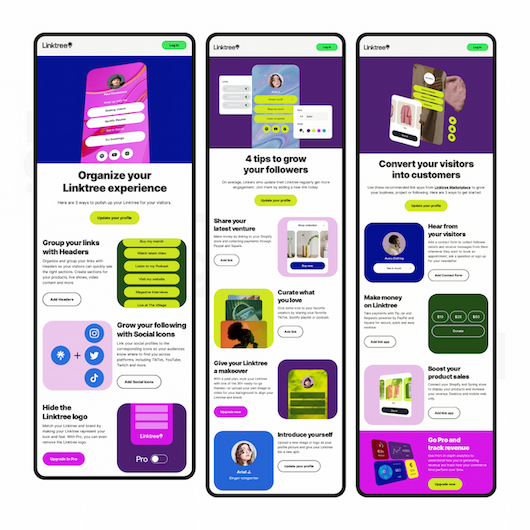To borrow from William Shakespeare’s famous line, “all the world’s a stage”, the strategies and tactics of lifecycle marketing start from the fundamental idea that consumers are all essentially actors playing their parts in a larger story — even if we typically see them as an audience rather than a player. From the initial introduction to your brand to the final “curtain call” of conversion, every interaction between a user and a brand shapes a certain narrative that influences decision-making from beginning to end. That’s why it’s important for marketers to understand how to leverage lifecycle marketing to capture attention and drive behavior at every stage of the user journey, fine-tuning messaging and influencing perceptions to move the narrative forward.
Essentially, each stage of the consumer journey presents a unique opportunity for brands to cultivate meaningful relationships, nurture loyalty, and drive sustainable growth. By tailoring strategies and messaging to meet the fluctuating needs and desires of consumers at each phase, brands can create powerful experiences that resonate on a deeper level.
What is customer lifecycle marketing?
Lifecycle marketing starts with the foundational idea that customers don’t just make a single transaction and disappear; rather, they go through various stages of engagement, from initial awareness to becoming loyal advocates. By tailoring marketing efforts to each stage of this journey, businesses can foster stronger relationships, drive repeat purchases, and ultimately boost long-term profitability.
What are the four pillars of lifecycle marketing?
The customer lifecycle typically comprises several key stages: acquisition, onboarding, retention, and advocacy:
- Acquisition stage: The primary goal is to attract potential customers and convert them into paying customers. This might involve tactics such as targeted advertising, content marketing, and search engine optimization (SEO) to capture the attention of prospects and encourage them to make a purchase or sign up for a service.
- Onboarding stage: Once a customer is acquired, the focus shifts to onboarding, where the aim is to provide a seamless and positive experience as they begin to use the product or service. This phase is crucial for setting the tone and building rapport with the customer, as it can greatly influence their long-term satisfaction and loyalty.
- Retention stage: This is perhaps the most critical stage of the customer lifecycle, as it involves keeping customers engaged and satisfied over time. This entails ongoing communication, personalized offers, and exceptional customer service to ensure that customers continue to derive value from the relationship. By delivering consistent value and addressing any concerns or pain points, businesses can reduce churn and maximize customer lifetime value.
- Advocacy: Finally, the advocacy stage involves turning satisfied customers into brand ambassadors who actively promote the business to others. This can be achieved through referral programs, social proof, and incentivized loyalty initiatives, harnessing the power of word-of-mouth marketing to attract new customers and further strengthen the brand’s reputation.

Lifecycle marketing is powerful because it allows businesses to maximize the lifetime value of their customers. Rather than focusing solely on acquiring new customers, which can be costly and time-consuming, lifecycle marketing emphasizes nurturing existing customer relationships to drive repeat purchases and increase overall revenue. By delivering ongoing value and staying top-of-mind with customers, businesses can encourage loyalty and advocacy, turning satisfied customers into brand ambassadors who promote the business to others. After all, it costs much more to acquire a new customer than it does to retain an existing customer — so why not invest in your existing customer base and turn them into advocates while you’re at it?
From a broader standpoint, lifecycle marketing also enables businesses to gather valuable insights into customer behavior and preferences. By tracking interactions and analyzing data at each stage of the customer lifecycle, companies can identify patterns, trends, and opportunities for optimization. This data-driven approach empowers brands to refine their strategies for other marketing channels, personalize communications, and deliver targeted offers that resonate with their target audience, ultimately driving higher conversion rates and ROI.
Is lifecycle marketing the same as CRM?
While lifecycle marketing and Customer Relationship Management (CRM) are closely related concepts that both focus on managing and nurturing customer relationships, they are not synonymous.
Lifecycle marketing refers to the strategic approach of engaging customers throughout their entire journey with a brand, from initial awareness to becoming loyal advocates. It encompasses various stages such as acquisition, onboarding, retention, and advocacy, with the goal of delivering value and fostering long-term relationships. On the other hand, CRM is a technology-driven strategy that involves managing interactions and relationships with customers through the use of data and analytics.

While CRM systems often support lifecycle marketing initiatives by providing insights into customer behavior and preferences, they are primarily concerned with organizing and automating customer interactions, such as sales, marketing, and customer service activities. In essence, while lifecycle marketing focuses on the strategic aspect of nurturing customer relationships, CRM serves as a tool to facilitate and optimize those efforts.
What is an example of a lifecycle marketing campaign?
An excellent example of a lifecycle marketing campaign is the welcome series employed by many subscription-based SaaS businesses. Imagine signing up for a new tool or online platform. After registering, you might receive a series of personalized emails or notifications welcoming you to the platform. These emails could include helpful tips for getting started, recommendations based on your interests, and invitations to explore various features or content. As you engage with the platform, the emails may adapt, offering additional guidance, special offers, or reminders to complete specific actions, such as setting up a profile or exploring premium features.
Linktree’s welcome email drip is a prime example of a well-executed lifecycle marketing campaign that aims to onboard and engage new users effectively. Upon signing up for Linktree, users receive a series of carefully crafted emails designed to guide them through the platform’s features and functionalities. The initial welcome email includes a warm greeting, an introduction to the service, and clear instructions on how to get started with setting up their Linktree profile.

As users progress through the onboarding process and begin to customize their Linktree profiles, subsequent emails in the drip campaign offer additional tips, best practices, and inspiration for optimizing their Linktree links and maximizing their impact. These emails may showcase examples of successful Linktree profiles, highlight advanced features and customization options, or provide insights into how users can leverage Linktree to achieve their specific goals, whether it’s driving traffic to their website, promoting their social media channels, or sharing important updates and announcements with their audience.
Throughout the welcome email drip, Linktree maintains a consistent brand voice and tone, fostering a sense of trust and credibility with new users while also encouraging them to explore and experiment with the platform’s capabilities. By delivering relevant and timely content tailored to each stage of the onboarding journey, Linktree effectively engages users, addresses their needs and expectations, and sets the stage for a positive and productive relationship with the platform.
What channels can be used for lifecycle marketing?
When it comes to lifecycle marketing, the key is to reach customers at every stage of their journey through various channels to ensure effective engagement and communication. The most common channels used for lifecycle marketing are email, SMS, and push notifications. Each of these channels have their unique strengths and weaknesses, meaning it’s important to understand the needs of your business and your audience base in order to determine which channel is most suitable for reaching your goals. It’s also common — and recommended — to use multiple channels at once, taking a holistic approach to leveraging the strengths of each channel when they are most effective and relevant. For example, many ecommerce businesses use email and SMS marketing in conjunction with each other, taking advantage of email’s ability to deliver rich content and detailed product information, while utilizing SMS for timely promotions, order updates, and cart abandonment reminders. This multi-channel strategy ensures that businesses can reach customers through their preferred communication channels and maximize their chances of delivering messages that resonate and drive action throughout the customer lifecycle.
Email remains one of the most versatile and widely used channels for lifecycle marketing. Whether it’s welcoming new subscribers, nurturing leads, or re-engaging dormant users, email allows businesses to deliver personalized messages directly to customers’ inboxes. Through carefully crafted campaigns, businesses can provide valuable content, promotional emails, and updates tailored to specific stages of the customer journey. With advanced email marketing strategies, tools, segmentation, and automation, businesses can ensure that their emails are timely, relevant, and impactful, driving engagement and retention. For example, smart ring brand Oura uses email marketing campaigns to announce the release of their new feature, aiming to convert interested prospects into satisfied customers.

SMS
SMS (Short Message Service) is an effective channel for delivering concise, timely messages directly to customers’ mobile devices. Ideal for delivering urgent updates, time-sensitive promotions, or transactional notifications, SMS allows businesses to reach customers wherever they are, with a high likelihood of being read promptly. By leveraging SMS marketing platforms and tools, businesses can personalize messages, segment their audience, and automate campaigns to maximize engagement and response rates. SMS is particularly useful for engaging mobile-centric audiences and driving immediate action, making it a valuable addition to any lifecycle marketing strategy.
Push Notifications
Push notifications are particularly powerful for engaging users who have installed a mobile app or opted in to receive notifications from a website. These notifications appear directly on users’ devices, providing instant updates, reminders, or personalized recommendations. Whether it’s notifying users of new content, promotions, or events, push notifications allow businesses to stay top-of-mind and drive timely interactions with their audience. By leveraging user data, behavioral insights, and segmentation, businesses can deliver targeted and relevant push notifications that resonate with users and drive engagement throughout the customer lifecycle.
To continue with the Oura example, here are some push notifications from the Oura app, aiming to deliver real-time updates and reminders directly to users’ phones, ensuring that they stay informed and motivated throughout their day. By sending timely reminders through push notifications, Oura Ring ensures that their members stay engaged with the app and remain committed to achieving their health goals, turning them into loyal users and advocates of the brand.

Here’s a handy breakdown of the strengths, use cases and platforms of each lifecycle marketing channel.

How does lifecycle marketing differ across different business types and industries?
Lifecycle marketing varies significantly across different business types and industries due to variations in customer needs, purchasing behaviors, and engagement preferences. For instance, the lifecycle journey for a subscription-based service like a streaming platform differs from that of an eCommerce store or a B2B software company.

ECommerce lifecycle marketing
In ecommerce, lifecycle marketing revolves around nurturing customers from the initial discovery phase through to repeat purchases and brand advocacy. For ecommerce brands, the focus often begins with lead generation through targeted advertising, SEO, and content marketing to attract potential customers. Once acquired, the emphasis shifts to providing a seamless shopping experience, personalized product recommendations, and incentives to drive conversion. Post-purchase, lifecycle marketing strategies aim to foster customer loyalty and retention through order follow-ups, loyalty programs, and targeted email sequences that encourage repeat purchases and referrals. Additionally, ecommerce businesses often leverage retargeting techniques and abandoned cart reminders to recapture lost sales and maximize customer lifetime value.

SaaS lifecycle marketing
Lifecycle marketing for SaaS (Software as a Service) businesses focuses on driving user adoption, engagement, and retention throughout the customer lifecycle. SaaS companies often employ a combination of educational content, product demos, and free trials to attract and onboard new users. Once onboarded, lifecycle marketing efforts center on providing personalized onboarding experiences, proactive customer support, and targeted communication to help users derive maximum value from the software. Customer success initiatives, such as regular check-ins, usage analytics, and feature announcements, play a crucial role in maintaining user satisfaction and reducing churn. Additionally, SaaS companies leverage upsell and cross-sell opportunities, as well as referral programs, to expand their user base and increase customer lifetime value over time.

B2B lifecycle marketing
In the B2B sector, lifecycle marketing is characterized by a longer and more complex buyer journey, focusing on lead generation, nurturing, and conversion. B2B companies typically employ a variety of tactics, including content marketing, webinars, and email campaigns, to attract and educate potential leads and move them through the sales funnel. Personalized lead nurturing strategies, such as targeted email workflows and account-based marketing initiatives, help build relationships and address the specific needs and pain points of prospects. As leads progress towards conversion, lifecycle marketing efforts may include product demos, free trials, and customer success stories to demonstrate value and facilitate decision-making. Post-sale, B2B companies prioritize customer retention and upselling through ongoing support, training, and product updates tailored to the evolving needs of their clients.
What are some lifecycle marketing strategies?
Regardless of which platform you use or which industry you’re in, here are some commonly used lifecycle marketing strategies that can be applied across a variety of use cases.
- Segmentation: Divide your audience into distinct segments based on demographics, behavior, or lifecycle stage to deliver targeted and personalized messages that resonate with their specific needs and interests.
- Personalization: Tailor your marketing communications and experiences to each individual customer, leveraging data and insights to deliver relevant content, recommendations, and offers that address their preferences and behaviors.
- Upselling and Cross-Selling: Identify opportunities to upsell or cross-sell additional products or services to existing customers based on their purchase history, preferences, or behavior, maximizing their lifetime value and increasing revenue.
- Customer Feedback and Surveys: Regularly solicit feedback from customers through surveys, polls, or reviews to gather insights into their satisfaction, preferences, and pain points, informing your strategy and improving the overall customer experience.
- Predictive Analytics: Leverage predictive analytics and machine learning algorithms to anticipate customer behavior and preferences, enabling proactive and targeted marketing initiatives that anticipate and fulfill customer needs.
- Referral Programs: Encourage satisfied customers to refer friends, family, or colleagues to your business through referral programs, offering incentives or rewards for successful referrals to drive customer acquisition and expand your customer base.
If you need more specific guidelines on how to implement a successful lifecycle marketing strategy, explore these additional resources on email marketing for SaaS, push notification marketing for driving retention, or talk to us to build a custom solution for your business goals.





